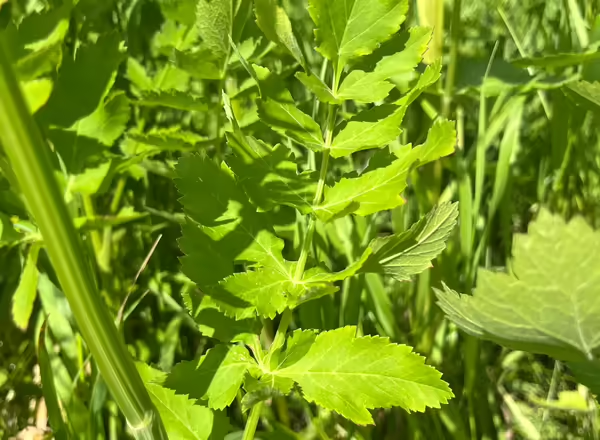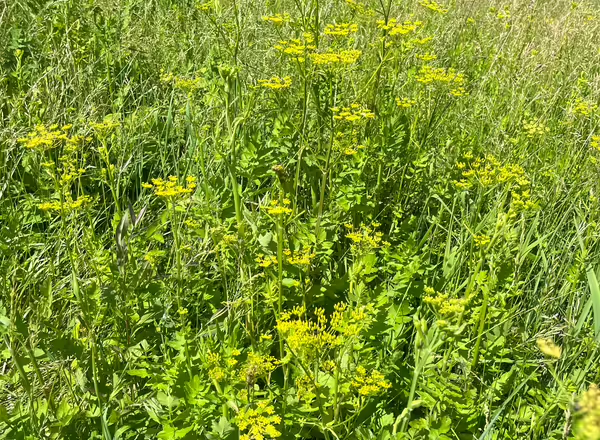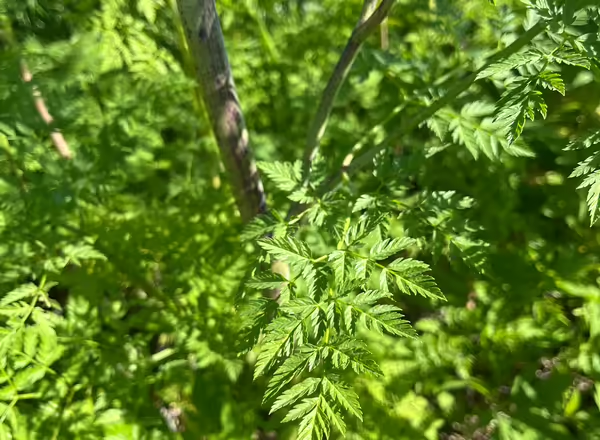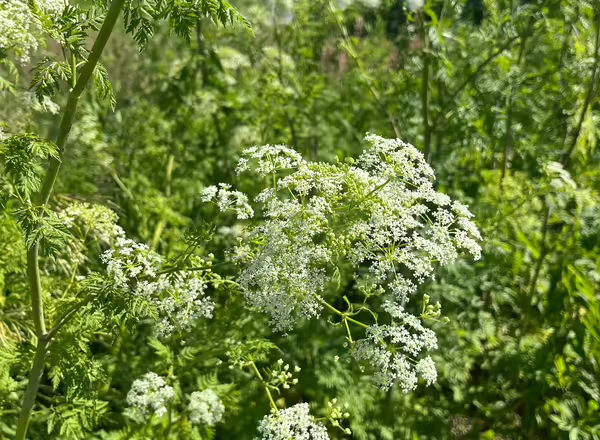
The other day, I had the opportunity to chaperone a school group at a local state park. While on the field trip, a volunteer-led the students on a nature hike through the woodlands. At one point during the hike, the group leader grabbed a handful of two plants to share with the students but in doing so, misidentified one of the plants. Luckily it wasn’t a harmful plant that was picked. Yet, as I scanned our surroundings, noting stinging nettles and poison ivy, it reminded me of the importance of knowing which plants have the potential to cause harm.
One family of plants that is familiar to us all and cultivated by many of us includes plants that can cause harm. The carrot family (Apiaceae) includes common garden species such as carrots, parsley, and celery. However, it also includes two species that grow wild and widespread throughout Illinois, contact with these plants can cause harm. Through proper identification of Wild Parsnip (Pastinaca sativa) and Poison Hemlock (Conium maculatum) contact can be avoided and management can be done in a safe and effective manner.
Wild Parsnip (Pastinaca sativa)
The sap of wild parsnip contains furanocoumarin, a chemical that can cause phytophotdermatitis – an increased skin sensitivity to sunlight resulting in an intense burn, rash, blisters, and discoloration. Skin sensitivity can last up to two years following contact. Minimize risk by avoiding contact with the plant through proper identification and wearing long sleeves and pants. If contact does occur, wash the area with soap and water and keep it out of sunlight. Severe burns should be treated by a medical professional.
Wild parsnip is an herbaceous biennial often found in roadside ditches, pastures, prairies, and unmown areas. Like all biennial plants, wild parsnip takes two years to complete its lifecycle. In the first year, rosettes of pinnately compound leaves develop low to the ground. By midsummer of its second year, two- to five-foot-high yellow umbel-shaped flowers are produced. If left unmanaged, wild parsnip can produce hundreds of seeds and spread prolifically.
Wild parsnip resembles Queen Anne’s Lace (Daucus carota), another common non-native species. Some people do experience a mild reaction to contact with Queen Anne’s lace although not to the extent of wild parsnip. Queen Anne’s lace produces white flowers rather than yellow.
Golden Alexander may also be mistaken for wild parsnip. The species can be differentiated by the leaves and blooms. Leaves of golden alexander are smoother with finer serrations than the deeply lobed and coarsely serrated leaves of wild parsnip. Flowers of golden alexander are yellow like wild parsnip but are unevenly clustered; wild parsnip blooms are more tightly clustered.



Poison Hemlock (Conium maculatum)
Poison hemlock is a highly toxic biennial plant found throughout Illinois. All parts of the plant contain toxic alkaloids which can be fatal if ingested. Symptoms of poisoning include nausea, vomiting, confusion, and respiratory distress, and can lead to death due to respiratory failure.
Contact with the plant’s sap may cause skin irritation and should be avoided. Protect your skin by wearing gloves, long sleeves, and pants. Avoid touching your face when working in areas where poison hemlock is present. If contact is suspected, wash the affected area immediately with soap and water. If ingested, seek medical attention.
Proper identification of poison hemlock is crucial. The invasive species can grow up to ten feet tall and is known for its smooth, purple-spotted stems. Leaves are finely divided, fern-like compound leaves similar to other members of the carrot family. Small white flowers are produced in late spring and early summer in an umbrella-like arrangement known as an umbel.
Poison hemlock can be confused with other members of the carrot family, such as Queen Anne’s Lace (Daucus carota), which has hairy stems and lacks purple blotches.



Management
Both species can produce an abundance of seeds. To help manage population growth, mowing can be done before seeds are set. When removing plant material with power tools, it is recommended that extra safety precautions be taken. Mowers with shrouded blades are recommended and personal protective equipment should be worn during management activities and handled with care after exposure. Small plant pieces thrown from power tools still have the potential to cause skin irritation.
Power tools such as mowers, string trimmers, and chainsaws have the potential to aerosolize sap making exposure and inhalation of sap particles more possible. Exposure to and inhalation of aerosolized sap can cause extreme health effects.
Horror stories of people being injured, even hospitalized after performing management activities abound. Have you heard the one about mowing crews that choose to go shirtless while performing maintenance activities ending up with torsos covered in blisters? Or the landowner being hospitalized for 100 plus days from symptoms suspected because of being exposed to aerosolized sap.
To manage plants mechanically, physically remove the plant including the entire tap root or chop the root with a shovel a few inches below the soil surface. After management activities are complete, clean equipment, clothing, and shoes carefully.
If chemical control is being used, herbicide applications need to be made following all label instructions and requirements. Generally, it is recommended that herbicide treatments target rosettes in early spring or late fall. Contact your local Extension office for specifics on herbicide use.
Understanding and respecting nature involves being able to accurately identify plants. Knowing which plants are beneficial and which have the potential to cause harm helps protect people and nature. Wild parsnip and poison hemlock are two locally abundant plants that present unique threats to people. By learning to distinguish these toxic plants from their look-alikes, we are better able to safely enjoy the natural world.
Good Growing Fact of the Week: According to the National Park Service, poison hemlock was introduced to North America in the 1800s as a garden plant. It was marketed as being a “winter fern”.
Thank you for reading!
Sign up for our emails! Want to get notified when new Good Growing posts are available? SIGN ME UP
Give us feedback! How helpful was this information (click one): Very helpful | Somewhat helpful | Not very helpful